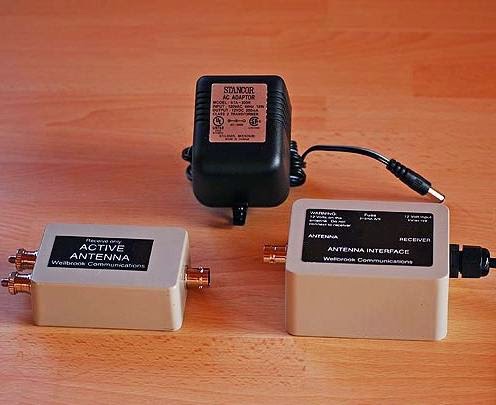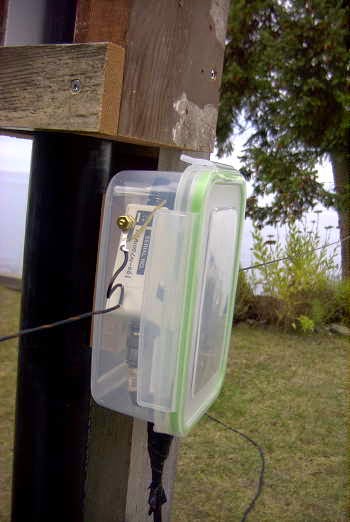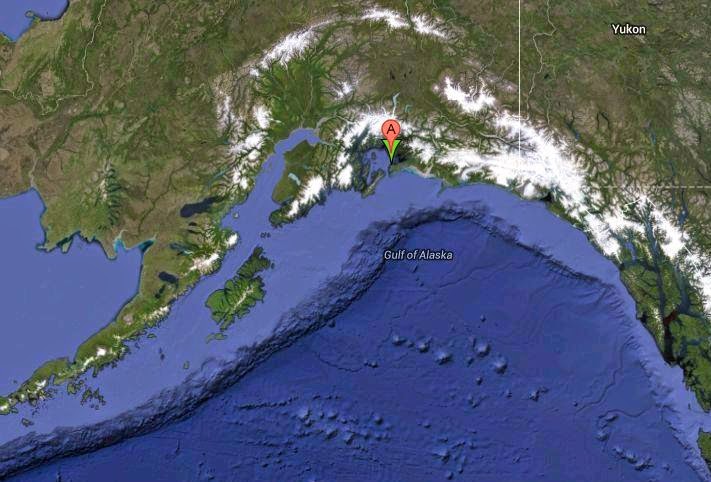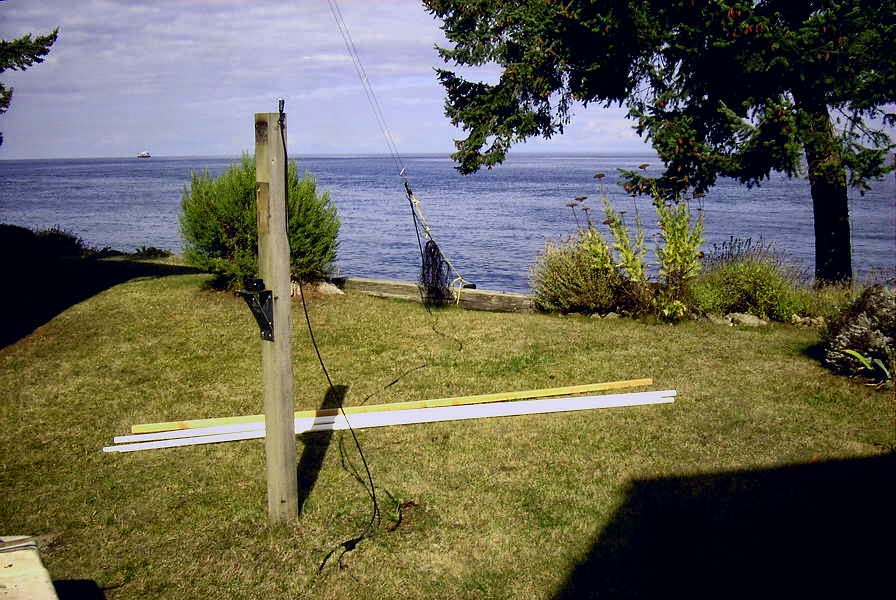 My 10’ x 20’ Active Loop
My 10’ x 20’ Active Loop
 |
| courtesy: americanradiohistory.com |
After recently installing a new coax run out to the loop and after five years of summer sunlight, the plastic food-storage container used to house the loop’s preamp (Wellbrook ALA100LN ... LF-30MHz) finally bit the dust ... literally.
Last week I replaced the housing with a slightly larger plastic box but I’ll still be faced with the UV bombardment and eventual deterioration of the clear plastic and lid unless I do something different.
I’ve a couple of thoughts but am hoping for some other suggestions from blog readers.
I have thought about spray painting the container, which may (or may not) prevent UV damage, but wonder if paint will stick to the smooth plastic surface? Maybe if scuffed-up a bit it would stick ... if so, the coating could be annually renewed.
Another idea is to cover it with duct tape ... not pretty, but possibly doing the job. Any other thoughts out there?
Part 2 and Part 3 of this blog were originally published when the loop was first built (2014) and describe the antenna details as well as showing the loop in action ... listening on the NDB and broadcast band as well as showing its nulling capability. It’s been a great performer and I can highly recommend the ALA100LN for a large aperture receiving loop. I’m looking forward to what will hopefully be a good winter of exciting loop DXing.
Part 2 - New LF / MF Loop
Some may recall my blog back in July (Wellbrook Loop Plans) describing a new loop that I had been thinking about as a possible replacement for my 10' shielded loop. I had been doodling various construction ideas using PVC tubing in an effort to keep it as light as possible, without introducing any metal near the loop. On Monday of this week, I dismantled the 10' loop in preparation for my new experimental rectangular loop.
 I've had the Wellbrook loop preamp here for a few months, so it was now or never, while the weather was still 'antenna-friendly'. Now I do understand that this goes against one of ham radio's long-standing traditions that dictates all antenna work must wait until the weather can't get any worse. Antennas built in the winter rain always work much better than ones put up in the summer. Hopefully it's not Wouff-Hong or Rettysnitch punishable but the fall DX season is almost upon us and I'm not waiting for the rain!
I've had the Wellbrook loop preamp here for a few months, so it was now or never, while the weather was still 'antenna-friendly'. Now I do understand that this goes against one of ham radio's long-standing traditions that dictates all antenna work must wait until the weather can't get any worse. Antennas built in the winter rain always work much better than ones put up in the summer. Hopefully it's not Wouff-Hong or Rettysnitch punishable but the fall DX season is almost upon us and I'm not waiting for the rain!The new 'loop' is not really loop-shaped but is rectangular (10' x 20') and more like a Flag antenna shape. I considered a Flag but really don't need any back-end nulling capability since I'm mainly interested in listening to the east and to the north.
The main boom section is composed of two sections of 1" PVC thick-wall (Schedule 40) pipe joined at the center and reinforced with a 10' section of 2" x 2" Douglas Fir. In addition, the boom has a truss of 1/4" Dacron to take out any end-loading sag. The vertical end sections are 3/4" Schedule 40 PVC pipe, fastened with a T at the boom end. The center mast is made of 2" Schedule 40 ABS pipe with a long section of 1 1/2" ABS nested inside that telescopes upward to anchor the truss ropes and give some additional rigidity to the mast.
 |
| Main boom and mast construction |
 |
| Looping E/W |

Although the preamp is completely sealed and weatherproofed, I still decided to mount it inside a container. The container also provided a convenient anchor to terminate the loop end wires (PVC-coated #18 stranded) without putting any tension on the soldered terminals.
Although I have not had much time to listen, and conditions are still in 'recovery' mode from earlier disturbances, initial indications are that everything is performing as well, if not better, than expected. It certainly outperforms my 10' active shielded loop by a large margin. I have yet to do any serious S/N comparisons between it and my primary LF receive antenna, a large inverted L, which must be tuned to resonance for the desired listening range. I believe that the very quiet loop / Wellbrook combination will provide an overall S/N improvement.
I have always believed that smaller loops provide deeper and sharper front-to-side nulls so I was pleasantly surprised to measure (using Perseus) null depths from 25-30db, on various groundwave signals ... more than expected. Skywave signals also deliver sharp deep nulls in the order of 22 - 25db ... again surprising, but I'll take them!
A brief listen while pointing S-E last evening turned up good signals from 1 kW'ers KYHN (1650kHz) in Fort Smith, Arkansas and KKGM (1630kHz) in Fort Worth, Texas. An early morning listen revealed good audio from JOIK (567kHz) Sapporo, Japan and JOAK (595kHz) in Shobu. Down in the ndb band, little 25-watter 'IP' on 210kHz was an all-time new catch from Mobile, Arizona.
There is still much to learn from this new antenna system but the biggest challenge will be keeping it up all winter. I did lose one of my 10' loops after several years, due to wind, when the main (un-reinforced) PVC mast eventually failed from flexing fatigue. I will tie the ends of the new antenna down when the winds get strong to reduce as much mast flexing as possible. I could however, run the risk of violating another long-standing radio adage ..."if your antenna stays up all winter, it's not big enough". I just can't win.
Part 3 - Loop Listen
As Murphy would have it, and in spite of the low amount of solar activity, LF/MF propagation has been very poor since getting my new 10' x 20' loop in place. The few front-to-side nulling checks that I have done, have produced results varying from around 20db to 30db, depending upon the signal. I suspect the depth of null is also affected by the signal's arrival angle but there is still more to learn. The pattern seems to be very close to that of a typical circular loop...the classic figure-8 pattern illustrated below as shown on the Wellbrook data that came with my ALA100LN preamp.
 |
| Courtesy: http://www.wellbrook.uk.com |
More typically, the null is around 21-22 db as shown on this test while listening to the ground wave carrier of the 'YZA' NDB (236kHz) located in Ashcroft, B.C., about 150 miles to the NE. As expected, the null is fairly sharp and the front / rear lobe, fairly broad.
One short check at dusk produced nice signals from CJBC, the French-language station in Toronto. The past few nights it has been very strong but with a strong echo effect. I wonder if there is more than one CBC outlet here (860kHz), such as a low-power repeater, causing the echo.
At the same time, while still fairly light outside, WCCO in Minneapolis had a nice signal just before sunset.
No matter how poor conditions become, it seems that the Hinchinbrook (Alaska) NDB, 'ALJ' (233kHz), is always strong ... looping north.
 |
| Courtesy: https://www.google.ca/maps |
(Since originally posting the above, I have been using the Tiny Take free screen capturing software, to produce better quality catures of my Perseus recordings. It's also probable that my new iPhone would produce a high quality video of my computer screen compared to the older iPad used for these ones, but it's something yet to be tried.)
Hopefully conditions will only get better as the season progresses and I am able to give the loop a good workout ... before it gets too windy!

















For the outside box – shy away from storage containers and anything made of Polypropylene like Tupperware.
PC or polycarbonate is usually a safe choice for material.
Any boxes made for marine use would be appropriate as they are made for resisting UV but can be costly.
Allied electronics has small plastic containers made by Bud Industries (budind.com). You could also consider outside electrical boxes made of plastic. Anything that states NEMA 4 is waterproof or has a high IP rating such as IP67.
A quick check shows that any decent exterior house paint is UV Resistant. BTW,
Good loop design. 73 Ken
Here in ZL I would use an ice cream container as they are made of ‘food grade’ plastic and are not recyclable .
Use of an etch primer before further painting would help the paint hold on.
PVC pipes used for external use are UV protected and have a UPC marking to various world wide ISO standards I beleive.
73
Peter
I like the design and what it’s potential is for the S/N ratio. Disabled due to a broken back last year, gives me some time to tinker. If I get a similar design I have the potential to mount it on a hinged aluminum (military) pole, approximately 38 feet high to see if slight elevation will have a positive effect.
73
Walt W4WLW
Lexington, NC
Walmart has some really nice water resistant containers in their camping department. I’ve had some out in our FL sun for years with no deterioration.
You may find suitable PVC junction boxes for outdoor installation at Home Depot, Lowes, and other home improvement stores. The usual sizes are 6 in x 6 in x 4 in and 4 in x 4 in x in although there are larger and smaller sizes as well. Many of these boxes ere UV resistant as well as IP rated. They usually have no pre-drill holes, which means that you must also purchase the necessary adapters to suit your specific wiring needs.
Gentlemen, thanks for all of your suggestions. It appears that a trip to Home Depot is in order. If I do nothing at all, the present one will be good for ~ 5 years. Any tape or paint will add to that, so I’ve got time to look.
Steve 73
Odd callsign I admit.. more on that later.
I enjoyed all the detail and complexity with this hi-gain loop. So you ask, ” any other suggestions from blog readers. ”
Well, yes. You end your interesting antenna feature with a naggaging doubt… Your words…to give the loop a good workout … before it gets too windy!”
The Canada Pointer antenna ignores the wind, has no mast, has no rotor, requires no guy lines and is a breeze and very cheap to make.
Pointer means fixed. Choose your favourite direction. Euorpe and Eastern USA for instance.
Requires one average tree at the feed end and a small tree or post at the target end. Requires two long lengths of nylon sash cord or even medium yellow poly rope will do. Size wise best for 11M…10M…and 6M. tuned.
I used found junk wire for mine. It was a black plastic covered stranded wire used for grounding on power poles. Or very similar. Found on a junk pile in a university experimental site on the junk pile in a
provincial park.
|The two nylon lines are strung from the tall tree parallel down to the post. You know the rest. Reflector first…say 16.8ft, then the vertical driven dipole..16.5ft and then twelve vertical hanging elements start5ing at say 4.4ft spacing and closing by 5% for each hanging element to the front end point. Tie the 50 – 52 ohm coax straight back of the feed point and fasten to the reflector so it hangs with the reflector.
Each black wire element is straightened and has a small twisted loop at each end for fastening to the main nylon lines.
I was able to get a pretty low SWR without baluns or anything alse. No antenna tuner to fool your radio and steal half your signal.
Let it snow, let it blow let it rain. My 11 watts of 12V battery LSB signal gets suggestions of Big Foot at times. What a waste that would be. I have never owned any RF amp and never will. Tony